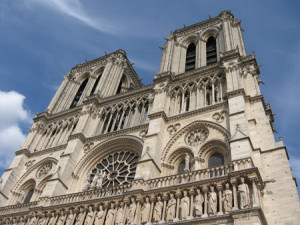Paris – tips for getting around
Greedy Girl first visited Paris as a 21 year old. Granted, her high school French classes were not as distant a memory as they are now, but that didn’t make her first Parisian experience that much easier.
She’s often mused that it’s rather a shame that one is taught how to ask for the most basic of requirements in a foreign country but it’s almost impossible to teach how to understand the reply. That’s because (a) Parisiansdon’tdrawbreathandruneverywordinasentencetogetherinanunintelligiblestream and (b) even the simplest question is often answered by a question. It’s not unheard of that the extraordinarily helpful phrase, practised until word perfect, Y-a-til quelqu’un ici qui parle anglais? (Does anyone here speak English?) can be answered by Non, pourquoi? (No, why?). Greedy Girl has been known to growl ‘If I could tell you why, I wouldn’t need anyone to speak English’ … but I digress.
First time visitors to Paris are wowed by the extraordinary architecture, the majestic landmarks and the sheer number of places to eat. For Greedy Girl, who loves her food (check out the many restaurant reviews and recipes here) it’s like being a kid in the world’s biggest sweet shop. But for those urbanites used to cities being laid out in an orderly grid system (NYC, I’m looking in your direction), Paris can also be a challenge to navigate, with all those delightful arrondissements radiating out.
The first arrondissement centres on the Louvre (hardly surprising given the system was developed by Napoleon III, whose lavish apartments are a must-see in that venerable museum) and the remaining 19 spiral out clockwise from there. It’s handy, if you’re looking for a particular arrondissement (a hotel address for example), to know which Paris landmarks are sited there – for example the Arc de Triomphe and Champs-Elysees are in the 8th, while the Eiffel Tower is in the 7th. The Pigalle – home to the nightclub strip featuring Moulin Rouge among others – is in the 9th and, if you keep walking in the same direction, you’ll move into the 18th arrondissement, home to Sacre Coeur and the Montmartre area.
Despite the roundabout numbering, Paris is one of the easiest cities in the world to walk in. It’s reasonably flat (Montmartre notwithstanding) and most buildings limited to a height of 37 metres (the forbidding Tour Montparnasse notwithstanding), so it’s quite simple to navigate using landmarks. Look up and walk towards the Eiffel Tower, Notre Dame, Sacre Coeur, the Arc de Triomphe, or the Concorde – the huge obelisk that marks the eastern end of the Champs-Elysees.
It’s also reasonably safe to walk around. Greedy Girl has travelled solo and with her beloved gluttonous husband. Being accompanied by a hulking brute helps keep some hasslers at bay but not completely – there are still a number of things to look out for – beggars, pickpockets and gypsies. However, on Greedy Girl’s last visit (July 2012) she spied relatively few beggars and, very happily, no pickpockets or gypsies.
Some areas are notorious for scammers – Montmartre (particularly near the Place du Tertre, more on that later), the leafy surrounds near the river Seine and out the front of Notre Dame and taxi queues outside the major railway stations (particularly the Gare du Nord, where the Eurostar arrives from London). If you spy (usually) a young girl making her way down a taxi queue plaintively crying out: ‘do you speak English’ as she passes by, the best strategy is to ignore her. You’ll save yourself significant irritation.
The Metro
But of course, some people don’t want to walk everywhere and if you want to cover off the city you’re looking at traversing around 90 square kilometres! This is where the superb Paris Metro system comes in.
The first metro line opened in 1900, to help ferry passengers to the second modern Olympic Games. The most recent line to be completed is #14, the ‘purple’ line which runs from Saint-Lazare to Olympiades. Even if you don’t use the Metro for any other purpose, it’s worth purchasing a ticket and trying to get into the first train carriage on this line because it is a completely automated service. There’s no driver. You sit at the front of the train and get a spookily illuminated view of the tunnels snaking through Paris’ underworld.
Completed in 1998, it is the only Metro line (so far) that offers lift or escalator access to and from platforms at each station – very handy when you’re toting heavy suitcases and heading for the Gare du Lyon, the train station servicing France’s ritzy southern destinations.
The colour coding of the Paris Metro makes it extremely easy to follow. All you need to know to navigate successfully is the line number or colour (unlike London, the Metro does not have names for its different lines) and the direction in which you need to travel. Transfer stations (where lines cross) are clearly identified by a solid white circle with a black border and a list of lines able to be accessed at that station.
Be warned – there are some very long walks underground when changing to different lines and lots of stairs. It’s also very helpful to have a Metro app on your smartphone or tablet – the age of the system means there’s lots of maintenance work.
Stations closed for prolonged periods are clearly marked in the route maps on board the trains but, at other times, stations can be closed temporarily – especially on weekends. An app helps you find a work around any closures – some you’re not aware of until you try to exit at street level which can be very aggravating and finding a full map of the system inside the station can be tricky. Learn to listen out for key words during announcements on the train and/or the platform mentioning a station name and the word ‘fermee’. Even if you do get caught out, there’s always a way around a closed station.
There are several tourist passes available that offer unlimited Metro rides as well as discounted entry to various attractions/museums. One is called ‘Paris Visite’ – the pass is available for one, two, three or five days.
The days are consecutive. If you purchase a five day pass with a view to using it for four days before you head off somewhere else and the final day when you get back to Paris, you’ll be disappointed. On the plus side, if you choose zones 1-5, you can use it for your trip to/from Charles de Gaulle or Orly airports and out to Versailles (or even Euro Disney, if that’s your thing). Paris Visite also has a zone 1-3 version (cheaper) which is perfectly acceptable if you’re not interested in the further reaches. But, more on airport transfers below.
There are also a number of other tourist passes that bundle in free or discounted admission to a range of museums and other Paris landmarks. These are very expensive and you need to be dedicated to get to as many of the featured attractions as possible to make them pay their way. Even Paris Visite is only worthwhile if you take lots of trips on the Metro. Lots. Having said that, if you’re visiting Paris in the winter, it could be handy. Walking in snow or on ice is not Greedy Girl’s idea of a good time. The passes also work on the bus network.
One of the most cost-effective ways is to buy a ‘Carnet’ of 10 Metro tickets which gives you a significant discount on the price of individual tickets. The tickets don’t expire. If you don’t use them, tuck them away in a wallet (away from any sources of magnetism) and they can be used on your next trip. Greedy Girl used two on her most recent trip that had been tucked away for two years.
You don’t even have to learn how to say ‘carnet’ (car-nay). You can select English on the vending machines at the stations and follow the onscreen prompts – or take your chances with your very best French intonation and line up at the ticket window. Just be prepared for someone to tell you that ‘your accent is terrible’.
What you don’t do is buy tickets from someone approaching you while you’re waiting in a queue. Chances are they’ve just scooped up a discarded, used ticket from the floor (or from their own pocket) and are trying to part you from your hard-earned Euro.
Don’t let the scammers stop you from having a wonderful time in Paris. Exercise common sense and don’t let yourself be swayed by things like the 101 artists at the Place du Tertre telling you that you have interesting/hair/eyes/nose/all of the above and get you to sit for half an hour while they do a portrait that parts you from a significant chunk of your travel budget. Unless you really want to!
Travelling from the airports
While the train network is brilliant in Paris, getting to and from airports using public transport can be time consuming, crowded and frustrating. If, like Greedy Girl, you’re prepared to deal with what comes your way and have a big strong individual prepared to tote the suitcases up and down various flights of stairs, then you can use your cash to better effect (i.e., eating out).
Planning the route to downtown Paris from either Charles de Gaulle (CDG) or Orly airport will serve you well.
It’s possible you’d use Orly airport, about 13km to the south of Paris, if you’re flying to or from a continental European destination. It’s serviced by a rail link and several buses and, of course, you can opt to book yourself a driver or get a taxi.
Greedy Girl investigated the Orly Bus which, with a few stops, drops you off at the Denfert-Rochereau metro station. It was a cheap option. Beware though – the bus doesn’t have a separate luggage compartment underneath so try to get on the bus early and score some of the very limited space if you’re travelling with bags. Otherwise it’s an uncomfortable ride nursing them through to the train station.
Different buses and trains go to different areas of Paris. We chose the Orly Bus because our hotel was on the same Metro line as Denfert-Rochereau and, from previous visits to Paris, we knew there was a lift at our destination station near the hotel.
It’s the same at CDG – a range of buses and the train, all dropping off at different points in Paris. As long as you’re confident in your ability to navigate (and apps are the answer) you shouldn’t have any problems making your transfers to and from the airports. Try to minimise the number of changes you have to make.
Naturally, you can hire a driver (expensive and sometimes not a great experience if your flight is significantly delayed) or get a taxi. This can also be an expensive option. The traffic coming in from Orly can be particularly bad and the meter ratchets up with maddening speed. Also, Greedy Girl has yet to have a taxi ride in Paris that wasn’t, shall we say, rather longer than it needed to be. It’s always a bad sign when the driver turns off the GPS and you get the distinct impression that your quick trip to a restaurant on the Left Bank seems to be going via Lyon.
You also should be aware that if you’re travelling with more than one bag, Paris taxis add a fee per additional bag. In fact, there’s a whole range of extra fees that can apply – for example, if you’re being picked up from a train station, if there are more than three people in the taxi and if you order a taxi by phone, the meter often starts when the driver accepts the job and starts heading in your direction, instead of when they arrive to pick you up.
If you’re lucky enough to not have to worry about the budget sit back, relax and enjoy the scenery – there’s plenty of it. That, of course, is one of the downsides of travelling by train in Paris – most of it is underground so you miss out on the splendour of Parisian architecture and the passing parade.
Segway/bike tours
Particularly in spring/summer these are everywhere. Helpfully, your Segway hire comes with a helmet and you pretty much stay on the footpaths but these can be narrow, treacherous and very crowded. Essentially these are guided tours, so if you come across a fabulous little cafe or brasserie on your travels, you’d need to make a mental note and try to find your way back there. Given the number of tourists Paris hosts each year, there’s a guided tour/walk for just about everything, if that’s your preference.
Hiring a car
What can Greedy Girl say about driving in Paris, except yikes. You’d need to be very comfortable driving on the right and have a high degree of confidence behind the wheel. Driving in Paris is sheer chaos. Before Greedy Girl first visited Paris all those years ago (this was pre-internet, people), she imagined the Champs-Elysees would be a quaint, tree-lined street crammed with cafes and kerbside tables and boutiques. Hah. It’s a six lane highway and getting around the Arc de Triomphe (at one end) and the Concorde (at the other) requires, well, not to put too fine a point on it, balls.
If you need a car to make the next part of your journey, perhaps look for a provider where you can pick up on the outskirts of Paris (in the general direction you want to head). Unless you know Paris well, driving in the city is a pretty insane idea. Leave it to the locals.







Comments